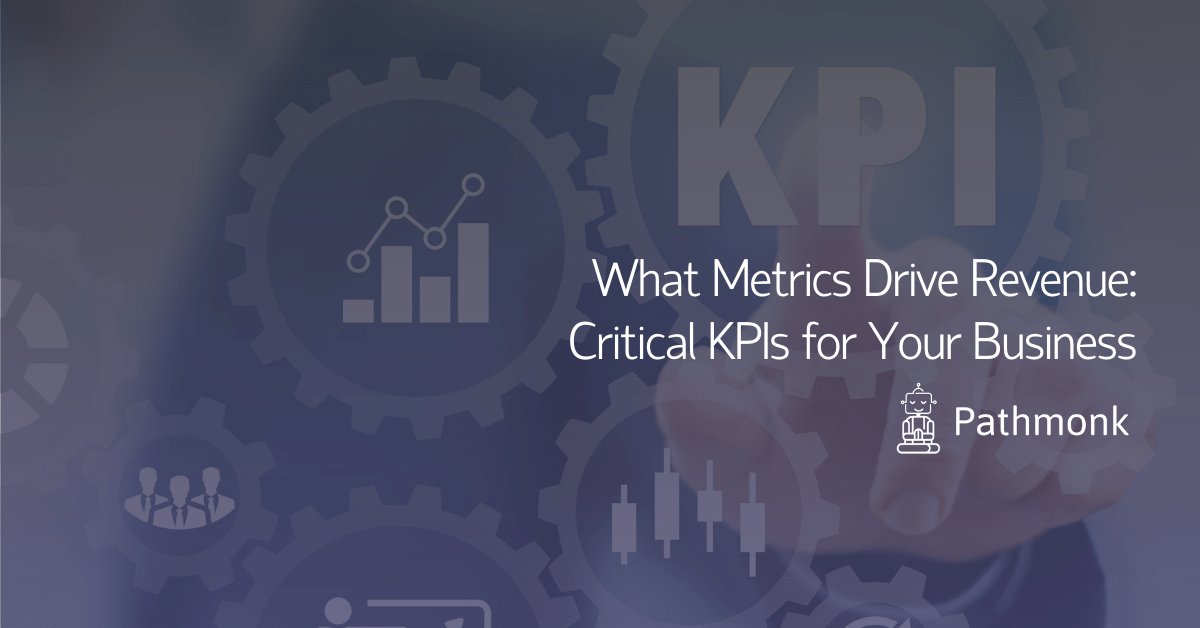
In order to see true growth in your company, it’s important to understand and track some very specific metrics and all the critical KPIs (key performance indicators).
Now, that sentence may make it seem as if there are countless potential metrics that you could track – and, to be fair, there are – and that attempting to follow them all could quickly become an overwhelming endeavor.
However, while this kind of data can help you get a good overview on how the business (or the employees or a department) is performing, not every KPI is directly related to revenue growth.
On top of that, in an article from the Harvard Business Review, they suggest that a single metric isn’t enough to understand what is driving revenue for your business.
Instead, they recommend a “constellation” of metrics would be more relevant for increasing revenue.
Now, they do say that it’s possible for one of the stars in the constellation to become a sort of “North Star” – the one that provides a little more direction for everyone.
But they are just as quick to point out that this does not give you permission to start ignoring the other stars around it.
According to this article, the “stars” in this constellation (the revenue metrics that matter) are related to: quantity, quality, and efficiency.
- Quality – These types of metrics usually refer to the type and level of service that a customer will (or can expect to) receive. In other words, the elements associated with this metric are related to satisfaction, engagement, or retention.
- Quantity – This is the easiest and most obvious one for companies to track (and to track obsessively). This metric is all about the products and how many of them go out the door and how much revenue comes back.
- Efficiency – This metric goes beyond the base numbers and looks at actual ratios of investment to profit. After all, it may look like a lot of money is coming in, but if it is not providing enough profit, then there is still work that needs to be done.
Depending on your business, any one of these metrics may seem more important at any given time, but a good balance of them all will still prove to be more effective and sustainable in the long run.
Let’s look at these metrics a little more closely and see what Key Performance Indicators fit within and help define them. This should make it easier to understand how they contribute to driving revenue.
Generate better leads to grow your sales
Discover new strategies to unlocking a flood of high-quality leads from your website.

Quality Metrics
While quantity metrics may be easier to obsess over, quality metrics can potentially contribute more to your overall success. The critical KPIs include:
- Engagement with Existing Clients – Clients that stick with you for extended periods are critical to ensuring long-term success. This is simply a matter of tracking how often your reps have an interaction with the customers and comparing it to the average length of a client relationship.
- Funnel Drop-Out Rate – This is important to show the number of potential customers who hit a speed bump in the sales funnel. You can calculate this number by taking the number of potentials in a particular conversion step and dividing it by the number of people that had reached the first stage of the funnel. This should highlight the areas in which your sales process could use some attention.
- Profitability Over Time – Tracking your expenses and income over a specified period to generate a detailed profit and loss report can show you whether it’s time to cut costs, raise prices, or look for more (and potentially better) clients.
- Customer Lifetime Value – This metric shows the total revenue your business can generally expect from a single customer over a given period of time. It’s possible to calculate this number with historical data or predictive numbers, and is simply a matter of multiplying the recurring revenue by the length of time the client is active. This is a particularly important metric because it can show you which buyer personas are most likely to drive more revenue and, therefore, should have the very best account managers assigned to them.
- Net Customer Worth – You can derive this number by subtracting the customer acquisition cost from the customer lifetime value. This KPI shows you the return on investment from each new client.
Quantity Metrics
These critical KPIs reflect the hard numbers that businesses like to see. They show your base revenue growth and highlight areas for expansion or improvement.
- Revenue Growth Rate – Of all your main business KPIs, this is the one that shows how your actual income is growing. You can arrive at this number by tracking your total revenue from one given period to the next. Then subtract the previous period’s revenue from the current one and divide that number by the total of last period’s revenue. Ideally, you will see positive growth, but if the numbers are negative you will know that it’s time to make some changes.
- Inventory Turnover – This is a simple measure of the number of units sold in a certain period of time. It shows you how well your company is keeping your products moving and can be calculated by adding the costs of the sold inventory and dividing that number by the value of the inventory still remaining at the end of the year.
- Cash Flow Forecast – This KPI is important because it will show you whether or not your margins will provide the necessary revenue and whether you will have a likely surplus or shortage. The simplest way to do this is by subtracting the cash spent (or expected to spend) from the cash received (or expected to receive).
- Income Sources – It’s important to know where all your revenue streams are coming from. Tracking this KPI will help you determine where the most profitable customer segments are and help you make better decisions about where to go next.
- Revenue Concentration – Is most of your revenue coming from a single source? If this is the case, your business may not have as strong of a foundation as you thought. If you find this to be the case, it may be time to diversify your efforts and either look for more/better clients or expand your offerings.
Efficiency Metrics
These metrics are all about working smarter, not harder. There are some important elements here that could show you ways to boost your revenue.
- Gross Profit Margin (as a percentage of sales) – This KPI is critical to your profitability. It ensures that you’re not paying more to your suppliers than you are actually bringing in through sales. Your gross profit margin is determined by dividing your gross profits by your sales. You can then divide that number by your sales amount to determine how much of your GMP makes up your overall sales. A decrease in this margin might indicate that you are overspending on supplies.
- Accounts Payable Turnover – How much is your business paying its suppliers in a given period? You can find this number by adding up the cost of total supplier purchases and then dividing it by the average accounts payable. This may show you whether or not it’s time to cut back on your spending.
- Cost per Acquisition – This KPI was mentioned under the quality metrics section, but it is more closely related the efficiency of your efforts. It is a simple measure of how much it costs to acquire a new customer. This could be a difficult number to reach, since it includes everything from marketing spend to employee salaries to overhead costs and much more. Once you have derived that number, though, you can divide it by the number of customers brought in by those efforts and call that the average customer acquisition cost.
- Conversion Rates – How effectively are you moving customers through the sales funnel? Are website visitors leaving immediately after they arrive on your site? Your conversion rate will show you how well your efforts are paying off and where you may need to improve the sales flow. This is tied directly to your revenue, so measuring your conversions can have a bigger impact on your growth than number of website visitors or sales leads alone.
- Sales Cycle Length – How long does it take to close a deal? How long will a customer take to make a final decision? Days? Months? Some sales take time – and there’s no way around that – but if they take too much time for too little payoff, something needs to be done. At the same time, if sales are closing quickly, but clients aren’t sticking around, it may be time to slow down.
Critical KPIs are More than Numbers
These revenue metrics should give any business a “big picture” look at their current performance. While it’s easy to just focus on the sheer volume of sales and assume that means everything is on track, going deeper will help you see exactly what is driving revenue and what may be holding you back.
Take the time and gather the data on KPIs like these and you will begin to get an even better picture of the inner workings of your company. This can help you determine the most effective ways to improve your ROI and reach your overall goals.
Just remember: these metrics are more than simple numbers. They are a reason to celebrate, a call for help, a warning of things to come, and a predictor of your eventual success.
Understand your customer journey analytics
See how your users behave, find drop-offs, and receive actionable insights with AI.









